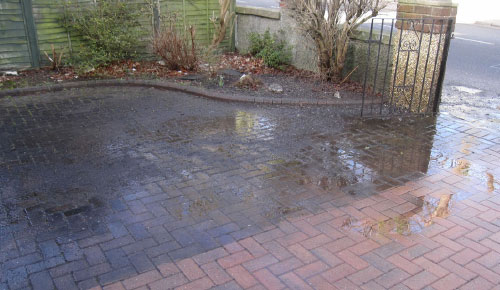-

Spring Cleaning: The Driveway
Spring Cleaning: The Driveway
 Share on Facebook
Share on Facebook
April 16, 2017
One of the most challenging parts of home ownership is keeping the driveway sparkling clean.
The good news is that with a little muscle and the right tools, you can keep yours spotless and increase your home’s curb appeal.
AUTO SPILLS
Unfortunate brake fluid, motor oil, and gasoline spills are extremely visible on both concrete and asphalt. Both require specific ways for cleaning.
Here they are.
First off, no matter what type of driveway you have, you need to soak up as much of the fresh spill as possible with an absorbent product like kitty litter. Let it absorb a few hours then scoop up the litter and finally sweep the entire area.
To remove any stubborn remaining spillage, use one of these cleaning techniques for your specific situation.
Asphalt: After absorbing the excess spill, spray a biodegradable oven cleaning product on the affected area. Let it sit for roughly 30 minutes. Then rinse it away with your garden hose. Oven cleaner will break down the remaining oil or solvent on the driveway, so you can safely rinse it away.
Concrete: Concrete’s slightly porous surface allows spills to seep into its tiny holes. So the best way to remove any remaining spillage is to dissolve it and then draw it out. Mix a powered moisture-absorbant product like corn starch for small spills or diatomaceous earth for large spills into the liquid TSP to create a thick paste. Spread it out over the affected area. Work it into the concrete surface with a stiff-bristle nylon brush. Then, spread an additional thin layer of the paste on top and let it dry. The TSP will break down the oil or solvent components and the absorbing product will bind them. The paste could take between 30 minutes to a couple of hours to work. Then, use a putty knife to scrape away the dried paste. Finally, rinse with a power washer or hose.
DIRT
For dirt and mud, start by power washing and brushing (if need be) the entire surface. Then rinse with a garden hose.
For real stubborn mud stains, sweep away loose dirt and bits, then dampen caked-on mud and let the water soak in for a few minutes. Then scrub away the loosened mud with a push broom to break it up. Depending on how much dirt you have to remove, the process can take a while. It’s important to use plenty of water.
RUST
Rust is an eyesore on concrete. Luckily, muriatic acid will remove rust stains without much trouble. Make sure to take safety precautions when using it. Wear long rubber gloves and protective eyewear.
Pour ¼ cup acid into a bucket already filled with 2 cups of cold water. If any solution splashes onto your skin, rinse it off promptly. Then, carefully pour the mix onto the rust stain and gently scrub the surface of the concrete with a stiff-bristle nylon brush. Allow the driveway cleaning solution to remain on for a few minutes before rinsing away with a garden hose. Heavy rust stains may require two or more treatments.
PAINT
Paint splatters and spills are a nuisance on both concrete and asphalt.
If you’re dealing with a latex-based paint spill, you can often remove it by wetting the splatter with water, sprinkling on a household scouring powder, then scrubbing it with a stiff-bristle nylon brush. And finally, rinse it with a garden hose.
Oil and acrylic-based paint is a bit tougher to remove. If you have an asphalt driveway, the best solution is to coat the driveway (or just the paint-splattered area) with an asphalt sealer, which will renew its black surface and cover splatters. For removing paint from concrete, simply strip it off. Pour or brush a paint-stripping solution on the splatters, and work it into the concrete with a stiff, natural-bristle brush. Leave it on for the time specified by the manufacturer and then rinse it away.
ORGANIC MATTER
You may not know it, but leaves, mulch, and pine needles can leave unattractive brown stains behind. As they decompose, they release tannin, which is a colorful byproduct of the decaying process. While the color will eventually fade, you can move the process along with a thorough cleaning.
Simply, sweep the concrete surface. Then spray the stained area with a garden hose to rinse away dirt. Take a large plastic bucket and mix ½ cup of liquid dish detergent into 3 gallons of hot water. Slowly pour the solution onto the tannin stains, then work the liquid into the concrete using a stiff-bristle nylon brush. Rinse with the garden hose. While the concrete is still wet, sprinkle powdered laundry detergent over the stains and scrub again. Leave the detergent on for a few minutes then rinse away. Repeat as necessary.

Feel free to stop into Builder Supply Outlet or the Edge Showroom with any home improvement questions you may have regarding tile, sealing, grout, backsplash, windows, kitchen cabinets, remodeling, construction, contractors, designing/installing a new kitchen or bathroom — or anything else. We can help you through the entire design and installation process from A-Z. Or call us anytime in Broadview, IL at 1-708-343-3900. You can also make an appointment to meet with one of our Edge Kitchen and Bathroom designers at no charge by clicking here.

- My account Cart
-
OPEN TO THE PUBLIC | Store Hours and Information708.343.3900 OPEN TO THE PUBLIC Store Hours and Information
- 708.343.3900 Español Schedule Your FREE
Design Consultation
